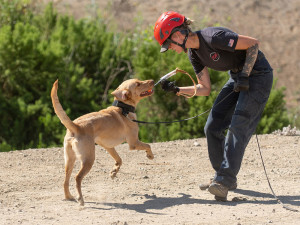Dogs Have an Internal Compass
Your dog’s sense of direction changes with the Earth’s magnetic fields, influencing their orientation when pooping and acting as an internal compass.

Share Article
Do dogs sense direction with their vision, smell, or something else entirely? Multiple studies provide evidence that a different mechanism may allow dogs to return to their starting point: magnetoreception, or the ability to sense the Earth’s magnetic field and use it as a compass. This incredible ability is almost as unbelievable as the powers of Haley Joel Osment’s character in The Sixth Sense. But it’s true. Dogs actually sync up with the Earth’s magnetic field to orient their sense of direction. Here’s how:
Dogs Are Tuning Into Magnetic Fields
In one study, researchers reviewed how sensitive dogs are to minor variations of the Earth’s magnetic field and demonstrated that dogs can sense and respond to magnetic fields. Researchers found a measurable change in the dogs’ behavior based on the conditions of the magnetic field.

Get (totally free) deals for food, treats, accessories, tech, and way more pet parenting must-haves.
opens in a new tabSpecifically, they found that dogs choose to pee and poopopens in a new tab under certain conditions with their bodies aligned along the north-south axis and avoided orientation along the east-west axis. They studied 70 dogs from 37 different breeds over a two-year period, observing 1893 defecations and 5582 urinations. Observations were all made while the dogs were off-leash and in open fields so that they were not influenced by walls, fences, fire hydrants, or other objects.
The researchers collected data on dog directionality and found that the way dogs face is not just a matter of chance. They ruled out such factors as timeopens in a new tab of day, angle of the sun, and wind conditions. Their analysis found that the Earth’s magnetic field explained dogs’ orientation when doing their business.
Interestingly, the pattern only emerged when the magnetic field was stable, which was only about 30 percent of the time. The Earth’s magnetic field can become unstable due to such factors as the variation in solar winds and the sun’s magnetic field. During such periods of instability, dogs did not show a preference for aligning themselves along the north-south axis and were oriented randomly.
Dogs Do Have an Internal Compass
Previous studies have found that cattle, deer, and foxes sometimes align their bodies with respect to the magnetic field. Sensitivity to the Earth’s magnetic field has previously been demonstrated in species that migrate, such as birds and whales, and also in honey bees, whose navigational abilities are legendary.
Of course, people have long asserted that dogs can find their way exceptionally well. It was, in part, dogs’ remarkable homing abilities that made the researchers suspect that dogs might be sensitive to the Earth’s magnetic field in the first place.
So, the revelation that dogs are able to sense the Earth’s magnetic field and that their behavior is influenced by it is outstanding. It has been known for a long time that dog senses, particularly the sense of smell, mean that they are responsive to stimuli that we humans aren’t aware of, but the fact that dogs can act, in some manner, as though they have an internal compass is just as fascinating.
Another published studyopens in a new tab may explain how dogs are able to sense the magnetic field. Researchers found that dog eyes contain cryptochrome 1, a light-sensitive molecule that reacts to the magnetic field when simultaneously stimulated by light.
This molecule plays a role in the navigational abilities of birds, allowing them to sense the magnetic field through the activation of the visual system. (Birds also detect the magnetic field through cellular-level ferrous particles, called magnetite, as do mole rats, who live underground.) In mammals, cryptochrome 1 has been found in only two of the 18 orders of mammals — carnivores (including canines but excluding felines) and primates (including orangutans).
Dogs’ Sense of Direction
Another piece of research reveals a way that being able to sense the Earth’s magnetic field influences dogs’ behavior. In this study, the researchers chose to focus on hunting dogs because they are generally considered to have amazing homing abilities. They outfitted 27 hunting dogs of 10 breeds with GPS trackers and collected data from a total of 622 daylight excursions in 62 locations. The dogs’ trips lasted 30 to 90 minutes and were undertaken in forested areas away from buildings, power lines, and roads. The paths they took out and back were the subject of the study.
Many dogs followed their own scentopens in a new tab back to the starting point using a method called “tracking,” which was observed in 399 returns. But in 233 excursions, dogs returned to the starting point via a novel route called “scouting.” In 50 cases, dogs combined both strategies in a single return route.
A majority of the dogs who returned by scouting began with a short run (about 20 meters/65 feet) along the Earth’s north-south axis; they did this no matter what direction they needed to go in order to return to the starting point. The researchers hypothesized that the dogs perform this initial “compass run” to get their bearings.
Though scouting dogs’ routes were far more likely to begin along a north-south axis, for tracking dogs, the direction of the start of the return route was random. Another difference was that the scouting dogs returned to their pet parents faster than the tracking dogs. Gender opens in a new taband breed did not influence the likelihood of employing scouting versus a tracking strategy, nor did wind or sun.
Activity along the north-south alignment of the compass axis is observed in many animals. Such behavior allows animals to access a universal reference frame that is so useful for navigation. Despite dogs showing some of the same abilities and mechanisms as migrating birds, marine mammals, and sea turtles, there is still so much more to explore about a dog’s sense of direction. What we do know so far is that they have their own internal compasses, just as people have been saying for ages.

Karen B. London, PhD, CAAB, CPDT-KA
Karen B. London, Ph.D., is a Certified Applied Animal Behaviorist and Certified Professional Dog Trainer who specializes in working with dogs with serious behavioral issues, including aggression, and has also trained other animals including cats, birds, snakes, and insects. She writes the animal column for the Arizona Daily Sun and is an Adjunct Professor in the Department of Biological Sciences at Northern Arizona University. She is the author of six books about training and behavior, including her most recent, Treat Everyone Like a Dog: How a Dog Trainer’s World View Can Improve Your Lifeopens in a new tab.
Related articles
![Trendy woman in a green coat walking her cute dog in a white jacket in public]() opens in a new tab
opens in a new tab6 Reasons to Set Boundaries for Your Dog
Well-trained dogs have more freedom (and more fun).
![SAR dog works with a trainer on search and rescue training]() opens in a new tab
opens in a new tabOnce Surrendered Shelter Pups Save Lives as Search-and-Rescue Dogs
Learn how the National Disaster Search Dog Foundation trains abandoned shelter pups to become SAR dogs.
![Woman wearing a neon green t-shirt, black pants, and a grey vest gesturing to a white dog on a leash while standing in front of a sign on a metal wall that reads "COVID-19 Testing"]() opens in a new tab
opens in a new tabCOVID-19 Isn’t Going Anywhere. Enter Dogs Who Can Sniff It Out
The answer to every (seemingly never-ending) crisis: Dogs.
![A man with a dog on a hike stoping to enjoy a beautiful overlook on a cliff.]() opens in a new tab
opens in a new tabHow to Take Silly Little Mental Health Hikes With Your Dog
It’s good for you both — promise.





